


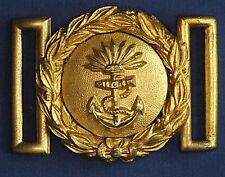
"Ordering the necessary tropical gear and uniforms from a city outfitter, I felt wonderfully mature as I tried on my first white suit." Commodore D G Baillie, A Sea Affair, 1957
Pride in a uniform contributed greatly towards the Company's 'esprit de corps' and for many years P & O Officers were justly proud of their uniform with its long traditions.
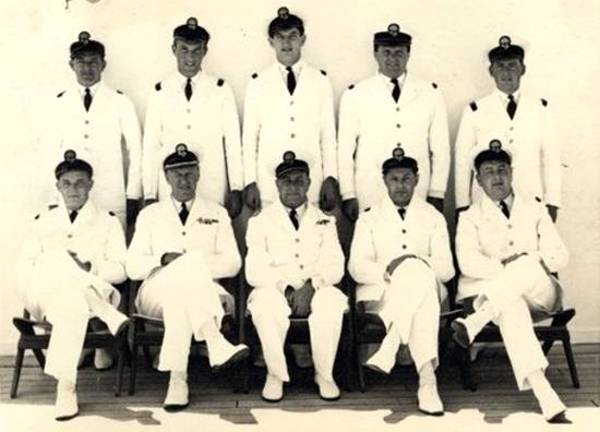
'The jacket is to have a turn-down collar to be worn with a white shirt collar and tie.
Shorts will not be worn, but the wearing of shorts in cargo ships is left to the discretion of the Commander.'
Source: P&O Regulations 1st April 1959.
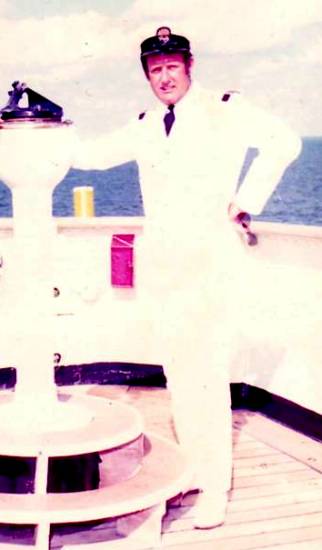
Nick Messinger, First Officer ss Chusan 1971
It's difficult to ascertain, with any accuracy, the identity of the person who designed this uniform - obviously, he never had to wear it himself. On board some ships, it was amusingly referred to as the 'ice cream suit.' Once clear of Biscay and the seasonal chills of a British winter, passengers were treated to their ship's company going about their duties in tropical whites, which I am reliably informed, lifted the spirits of all on board. Stiff with starch, the well pressed trousers and long-sleeved jackets took some getting into, and before the advent of air conditioning, were uncomfortable in the tropics. Prior to the invention of collar attached shirts, it necessitated the wearing of a heavily starched cutaway stiff collar, which only added to the wearer's acute discomfort. On an open bridge, steaming down the Red Sea with a following breeze and breathless humidity, it was nigh on unbearably uncomfortable. Fortunately, salt tablets were provided by the Company.
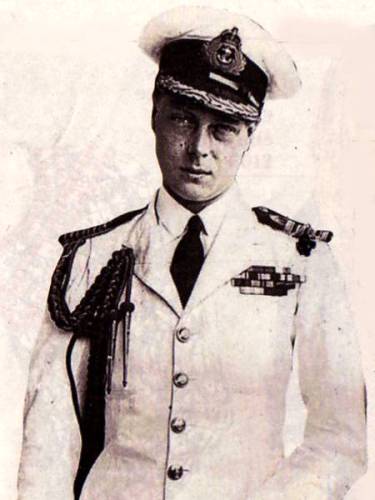
Perhaps the designer took his lead from the self-publicising Prince of Wales, later, briefly, King Edward VIII. Known for the sartorial elegance of his wardrobe, and having given his name to the Windsor knot.
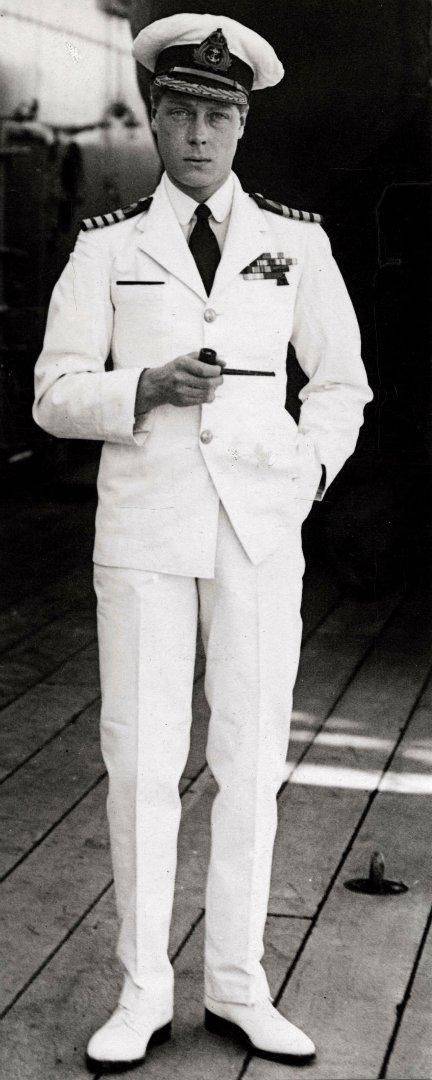
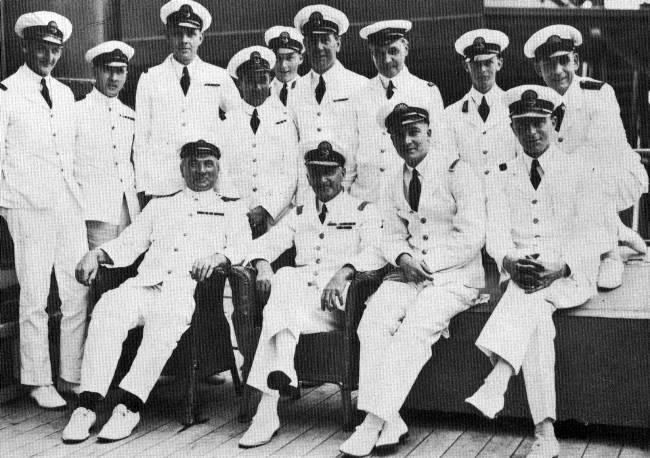
Captain Browning and Officers of the ss Maloja, 1923. The Chief Engineer, seated on the Captain's right, is wearing standard Merchant Navy / Royal Navy high-collared tropical whites - (but with black socks!).
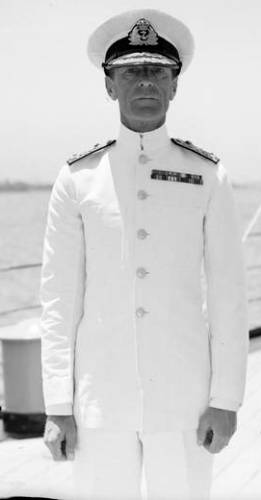
Royal Navy Tropical White Uniform, also worn by Marconi and Orient Line Officers.
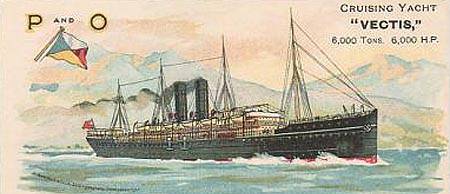
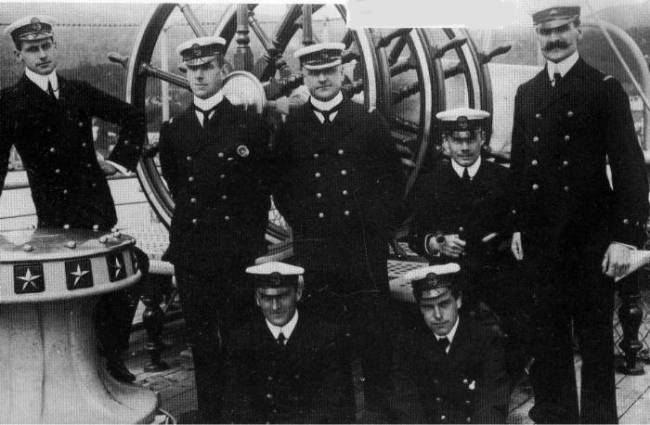
Aboard the Cruising Yacht Vectis of 1901, her Officers are wearing Royal Navy style frock coats, with eight gold buttons, cap badges and rank insignia, worn as shoulder straps, as follows:-
The Commander - straps of half-inch gold lace on each shoulder and three gold buttons on each of his cuffs;
The Chief Officer - a strap of similar gold lace on the right shoulder and three gold buttons on the cuffs;
The Second Officers - just the three cuff buttons
The Junior Officers - no shoulder straps or cuff buttons.
The moustachioed gentleman standing on the right in the above photograph is the ship's Purser, wearing a single shoulder strap on his left shoulder, three buttons on the cuffs, and a rising sun cap badge, while the Commander and Deck Officers wear a gold rising sun and anchor on their caps, which saw service until 1972, when a cap badge incorporating the P&O house flag was introduced across the entire P&O Fleet, including ferries, tankers and cargo ships of all shapes and sizes. Similarly, shoulder straps were replaced with shoulder boards, or epaulettes, with 'four-and-aft' gold stripes.
These changes marked the end of an era, and a history dating back over one hundred and twenty-five years.
"Ordering the necessary tropical gear and uniforms from a city outfitter, I felt wonderfully mature as I tried on my first white suit." Commodore D G Baillie, A Sea Affair, 1957
On joining the Company, a major expense was the purchase of uniforms and kit. RNR Cadets, Midshipmen and Lieutenants had the advantage here, as their naval uniforms, supplied by the Admiralty at no cost, could be modified, simply by removing collar patches and cuff braid, in exchange for (cheaper!) P&O insignia.
There were three major purveyors of uniforms....
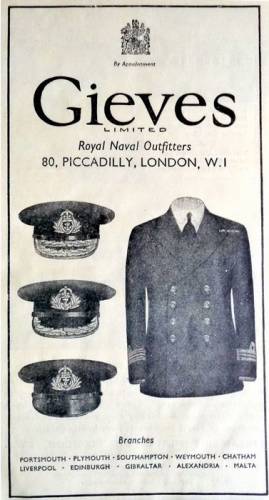
Founded in 1771, the quintessential British luxury brand for a gentleman, Gieves has over two centuries of trading history, and for over 100 years has resided at its iconic London address, No. 1 Savile Row – the home of bespoke tailoring and a destination for those seeking the ultimate sartorial experience. The company's lineage is remarkable; in the very beginning, Melchisedek Meredith owned a tailor shop in Portsmouth, where he became famous for military uniforms. His pedigree was impeccable,for he had crafted the uniform worn by Admiral Lord Nelson when he was killed in action at the Battle of Trafalgar in 1805. In 1841, the business was sold to Joseph Galt, and James Gieve joined as a partner 11 years later. Eventually, James Gieve took control in 1887, and established Gieves & Co. He died just a year afterwards and his two sons, James W. Gieve & John Gieve, took over the business. By 1900, Gieves became tailor by appointment to the Royal Navy. In the following decade, Gieves received a number of Royal Warrants and established their premises in two different locations on Bond Street.
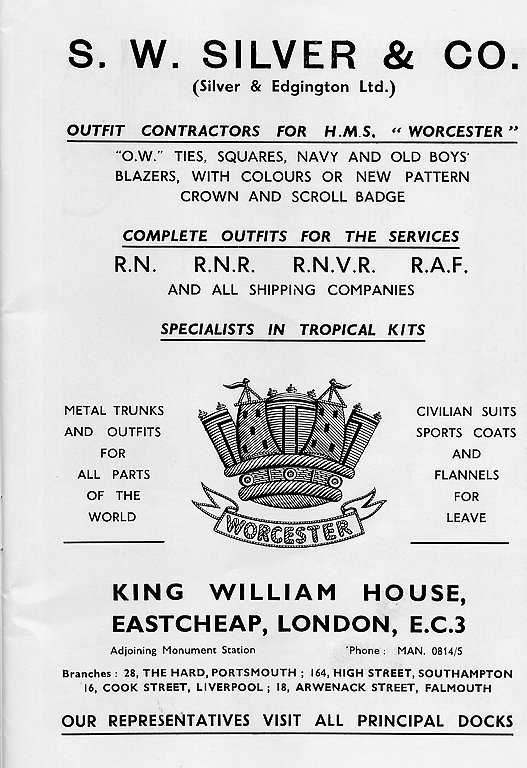
A slightly less expensive source of uniforms was S.W. Silver & Company of Cornhill and Bond Street in London, which was established in the 18th Century by Stephen Winkworth Silver as army and colonial agents, clothiers and outfitters - well-known retailers of campaign and exploration equipment. They also acted as shipping agents, and as suppliers of uniforms to both Worcester and Conway cadets - the company effectively gaining the advantage of a captive clientele as the cadets graduated and joined the Merchant and Royal Navies. From 1902 - 1953, the company had premises at 106 High Street, Portsmouth, with a headquarters at King William House, Eastcheap in London.
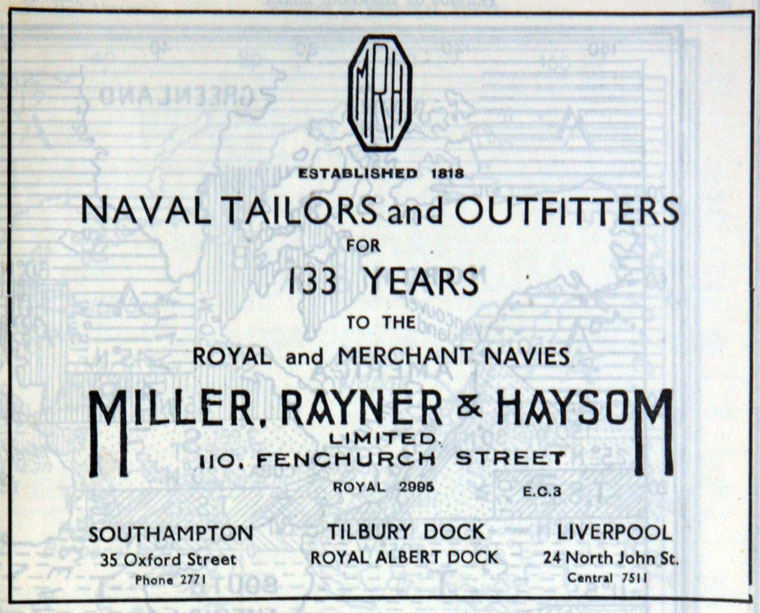
More economical still were Miller Rayner & Haysom, who supplied 'ready-to-wear' uniforms, alongside their bespoke tailoring. The company has an impressive 200 year history, as one of Britain’s leading suppliers of crew clothing for marine, aviation and land-based companies. It all began in 1818 when George Miller established the business, called simply ‘George Miller’. In 1912, nearly a century after it was founded, the company became ‘Miller, Rayner, Haysom Ltd: Naval, Military, Shipping & Colonial Outfitters’. By this time, it had added branches in Paris and Rotterdam and a manufacturing operation in Liverpool. In the same year, the company notably manufactured crew uniforms for White Star Line’s Titanic and Olympic Class. The birth of George’s two sons, led to it evolving into ‘Miller & Sons’, with one son, Alfred, managing the Southampton branch in Oxford Street, and Charles running new offices in London and Tilbury.
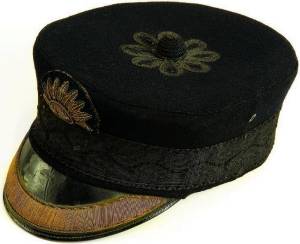
P&O Commander's Cap c1900 - The Station Master's Hat!
Early in the Great War a circular was issued by the P&O Tilbury Dock Superintendent to all Commanders:—
'At the request of H.M. Government an alteration is being made in the Company's Regulations as to uniforms whereby all gold lace straps worn on the shoulder are to be one quarter inch width instead of a half inch as heretofore and all gold lace stripes worn round the cuff are to be half inch instead of three quarters of an inch as at present'.
In the same month a full reprint of the Uniform Regulations was included in the Book of Regulations incorporating this amendment and for the first time the rank of Inspecting Purser appears. This important person was to wear two quarter inch straps on the left shoulder, half an inch apart, on a white ground whilst the Purser continued to wear one strap only.
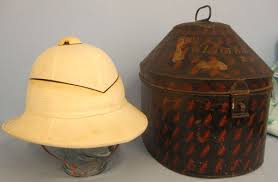
On the subject of headgear, only the cap and a helmet with white puggaree* were mentioned.
* a thin muslin scarf tied round a sun helmet so as to hang down over the wearer's neck and shield it from the sun.
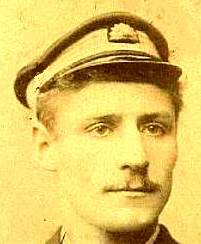
In July, 1917 a further interesting amendment was made when the Engineers' cap substituted a black mohair band for the inch and a quarter gold lace band previously worn.
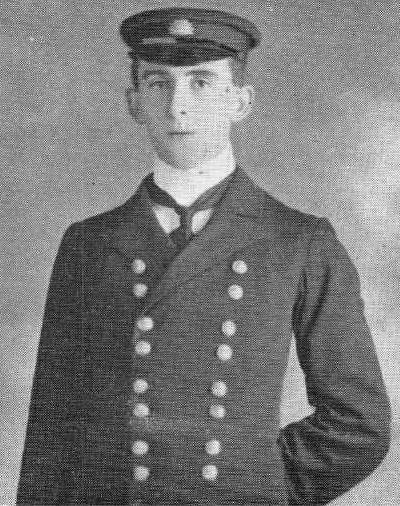
L.A.Williams, Assistant Purser
By 1920 the Frock Coat was fast losing popularity and in the September of that year the Directors issued a circular stating that 'the Frock Coat need not in future be insisted on'. Thereafter it was permissible for Officers to wear Reefer Coat for Full Dress but doubtless the whole subject of Full Dress had, in any event, been in abeyance throughout the War.
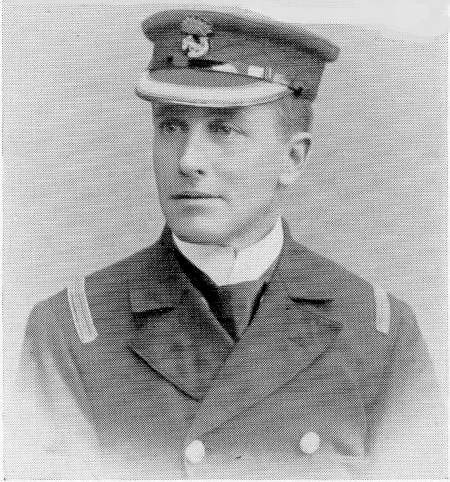
J.B.Fox, Commander
The First World War had brought about a fuller recognition by the public of the vital part played by the Merchant Service and in September 1918 His Majesty King George V approved a Standard Merchant Navy Uniform.
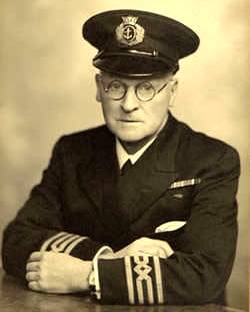
The stripes were originally of half inch gold lace on blue uniforms and black mohair on white uniforms, but in 1921 the width was reduced and with the passage of time and the wearing of short sleeve shirts, the black mohair stripes had disappeared and were replaced by Naval pattern shoulder straps with appropriate merchant Navy Rank insignia.
It was hoped by those responsible for the introduction of this Standard Uniform that its adoption would become general throughout the Merchant Service and those Companies having their own uniforms were expected to encourage their Officers to wear the new uniform. Accordingly the Directors of the P & O issued the following Circular to their Commanders on 22nd September 1920.
'We are informed that on board some ships pressure has been brought to bear with regard to wearing Standard or the Company's Uniform. Please note that we wish this matter to be left entirely at the option of Members of the Crew.'
In 1922 Regulations for the P & O Branch Line, a copy of the Uniform Regulations states that 'The Standard Uniform of the Mercantile Marine may be worn, or alternatively the Company's Uniform.'
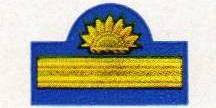
Commander
Despite the official Management approval of the Standard Uniform by the Directors, one cannot help but wonder how many P & O Commanders approved its wearing in their ships - and whilst one assumed that this Circular has never been actually cancelled, there is no mention of it in any Uniform Regulations up to 1972, and the Standard Uniform was certainly not worn in the Company's ships up until 1972.
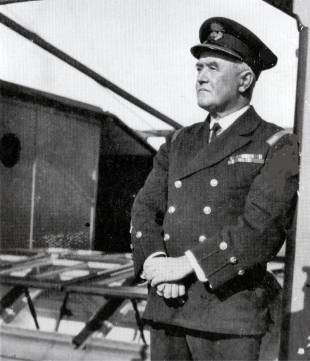
Rhodes, Commander, ss Mongolia 1920
The amended page of Uniform Regulations issued in October 1920 had the addition of the Reefer Coat which was to be of 'Blue Cloth or Serge, Double breasted, to button four' and the three cuff buttons previously worn by Senior Officers were dropped. Other minor alterations included a reduction in the number of waistcoat buttons from eight to six. By January 1923 when full details of Uniform Regulations were again to appear, there was no reference to the Frock Coat and the only coat referred to was to be of 'Blue Cloth, Navy pattern, D.B. Four Company's buttons.'
Further Regulations issued in January 1924 enlarged the quarter inch gold lace to three quarter inch (prior to 1916 it had only been half inch) for Commanders, Chief Officers, Surgeons and Pursers, (the Inspecting Purser had two stripes of five-eighths inch lace) but more importantly it introduced at last a rank marking for Junior Navigating Officers and Pursers.

The Second Officer was henceforth to wear 'A strap of dark blue cloth with two rows of three-eighths inch gold wire navy lace across the centre of the strap three-eighths inch apart, light blue cloth between the rows on the right shoulder.'

The Third Officer wore one such row of gold lace ......

and the Fourth Officer wore one row of quarter inch lace.
There was no longer any reference to Fifth Officers and the Assistant Purser was given the same as the Fourth Officer, but on a white background, and it was to be worn on the left shoulder.

This was also the first time that anything was mentioned in the Uniform Regulations about Apprentices, who wore a vertical stripe of Russian gold braid on the right collar but they had, of course, been carried in P & O ships for many years.
These Regulations brought a change in caps too. The Commander hereafter wore gold leaf embroidered round the outside edge of his peak in place of the 'plain gold embroidery' which had made him look rather like a station master.
The introduction of two stripes for the Second Officer and one for the Third Officer was undoubtedly the influence of the Standard Merchant Navy uniform.
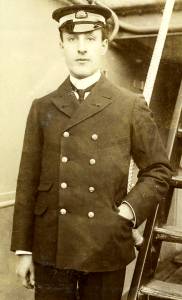
Junior Engineer c1900
In October, 1924, its influence was further felt when P & O Chief and Second Engineers were each given an extra stripe. For the first time too, other Engineers were given distinction lace, two stripes for the Third Engineer and one for the Fourth.

These stripes were to be of three-eighths inch lace and Junior Engineers, Boilermakers and Refrigerating Engineers were to wear one thin stripe of quarter inch lace and the Electricians a quarter inch stripe with a half diamond above.
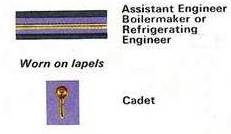
More important was the introduction at last of a colour for the Engineers who were to follow the Naval custom of wearing purple between the stripes on their cuffs.
Another interesting point concerning this amendment is that there is no reference to Inspecting Pursers who do not appear again!
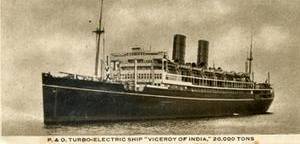
The building of larger ships, in particular the Viceroy of India in 1930, Strathaird in 1931, and Strathnaver in 1932, brought about the additional ranks of Staff Commander, First Officer and Deputy Purser for whom provision had to be made in respect of their uniforms.

In 1933 the following amendment to the Regulations appeared: Commander, three-quarter inch gold lace stripe surmounted by a gold embroidered P&O Sun, the whole mounted on a light blue cloth with a quarter inch overlap all round. To be worn on each shoulder.

The Staff Commander was to wear the stripe on each shoulder without the sun, as previously worn by the Commander.
First Officer

When the P & O Regulations were reprinted in 1937, there was provision for the First Officer to wear the same as the Chief Officer ......

but with a three-eighths inch break in the centre of the gold lace, and for the Deputy Purser to wear the same but with white cloth beneath.
Whether this was the first time these new rank markings were actually instituted is not known, because they may have been promulgated earlier by a Circular or by word of mouth. The 1937 Uniform Regulations were reprinted in 1938 without change and remained in force throughout the Second World War, but as in the Royal Navy a good deal of relaxation was accepted and other rigs appeared, including 'Battle Dress' which was a most practical war-time uniform.
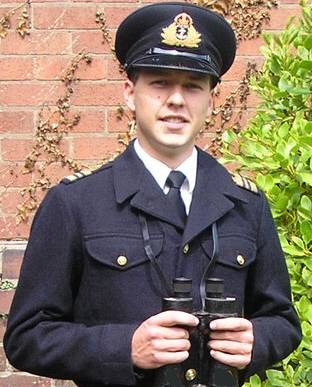
A number of shipping companies have continued to wear 'Battle Dress' and in many cases it has superseded the blue 'patrol jacket and trousers' which was so common in the Merchant Service between the wars. Neither of these uniforms however has found favour in the P & O and the only 'relaxed' uniforms which have been adopted are for use in warm climates.
The P&O and Royal Navy distinguish between mess dress, which is now the equivalent of civilian white tie, and mess undress, which is the equivalent of black tie.
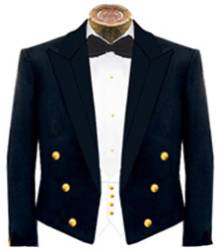
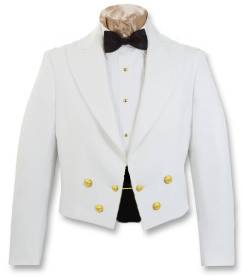
On board passenger ships of the P&O, both blue and white mess kit was worn, while there were two forms of evening dress:
Mess Dress - mess jacket, plain navy blue mess trousers, white waistcoat, black bow tie.
Mess Undress - mess jacket, plain navy blue mess trousers, blue waistcoat or black cummerbund, black bow tie
Today, mess dress and mess undress are worn with a soft marcella-fronted shirt with a soft collar. In some ships, stiffly starched 'boiled shirts' with stiff wing collars were worn with all forms of evening dress, but had been phased out by 1972.
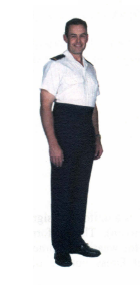
The white shirt and shorts with long white stockings, introduced into the Royal Navy in 1937, was permitted to be worn onboard cargo ships, subject to the Captain's approval, as per P&O Regulations, and for evening wear in these ships a modification of the Naval 'Red Sea Rig' with white shirt, white trousers and cummerbund and black shoes was worn.
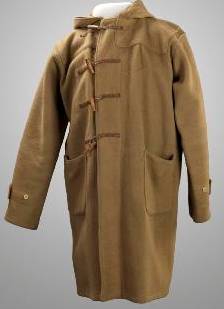
As in the Royal Navy, the utilitarian duffel coat of the war years replaced the expensive and rather impracticable Naval Bridge Coat.
It was 1947 before further serious thought was again given to uniforms and the amendments then issued introduced many important changes. Henceforth all Officers, regardless of Department, were to wear the full cap badge, consisting of the Rising Sun and the Anchor which latter had previously been the prerogative of the Navigating Officers, and the Company's distinctive shoulder straps were to be worn on both shoulders.
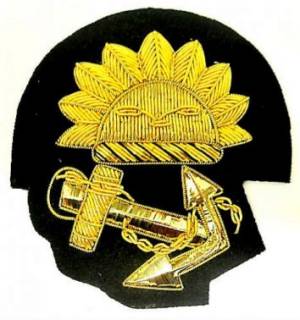
Senior officers' shoulder straps underwent considerable modification, with the discarding of the single large gold stripe, and Chief Officers, Surgeons and Pursers received three rows of nine-sixteenth inch gold navy lace across the centre of the strap, three-eighths of an inch apart, each with their own departmental colour beneath and as stated above they were to be worn on both shoulders. The First Officer, Assistant Surgeon and Deputy Purser received similar treatment except that their middle row was to be of only quarter inch lace, giving the effect of 'two and a half' stripes.
1947 also saw a major change in the uniforms of the Purser's Department ratings. In the immediate pre-war period braid was not worn on the cuff by ratings and only the most senior had anything but a plain uniform. The Chief Steward then wore three gold stars on each cuff and his immediate juniors, the 2nd and 3rd Stewards had two and one star respectively, whilst all other Leading Hands wore only blue enamel badges on their breast pockets stating their function. In January, 1947 however, silver braid was introduced for all Leading Hands with the exception of passenger ship Chief Stewards who were to wear three zig-zag gold stripes. Cargo ship Chief Stewards and 2nd Stewards in passenger ships each received three half inch silver stripes and 3rd Stewards two such stripes, whilst other Senior Leading Hands acquired 'one and a half' silver stripes. Junior Leading Hands wore only a quarter inch stripe on their cuffs. This remained unchanged until 1972, except that cargo ship Chief Stewards now wore two zig-zag gold stripes in place of three silver ones, and with the granting of Officers' status to Chief Stewards, together with introduction of the full cap badge for all Officers they wore the gold Rising Sun and Anchor.
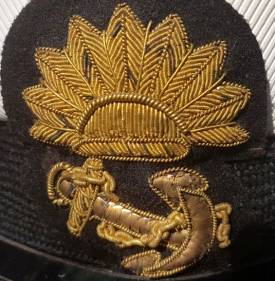
It was somewhere about this time too, that a small but significant alteration was ordered to the cap badge. For more years than are recorded the Rising Sun of the Officers' cap badge had displayed a 'face' consisting of eyes, nose and mouth, but from this time it began to disappear and badges were made without the face. As mentioned earlier, the cap badge had come in for its share of minor alterations over the years, both with regard to the angle of the anchor and with the size of the sun Tailors and outfitters were informed of alteration largely by word of mouth and this information was then passed on to the embroiderers and gold lace- makers. It is not surprising therefore, that these differences are to be found in the Company's uniform over the years and, in any event, at one time it was possible to purchase two sizes of P&O’s sun.
After 1947, when so many alterations had been made to the uniform, the P & O Company began a period of steady and rewarding trading, during which time the overall pattern of the Company's activities varied very little. During this time the opportunity was taken to re-write 'P & O Regulations' incorporating all the amendments to Uniform Regulations that had been made shortly after the war, but no sooner had they appeared in print - than a further spate of amendments appeared in quick succession.
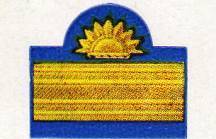
In 1953 the Official rank of Commodore was instituted and the Senior Commander was given a larger version of the Commander's shoulder strap consisting of a one and a half inch gold lace stripe surmounted by a gold embroidered P&O Sun, mounted on a light blue cloth.
Commodore D C O Baillie in 1954.
By another amendment of the same date, the Surgeon of a cargo ship had his three stripes reduced to two, similar treatment to that meted out to Assistant Surgeons of passenger ships in the previous year. 1953 also produced an amendment to 'P & O Regulations' giving details of uniforms for Nursing Sisters, Children's Hostesses and Stenographers, and although these ranks were not new, their uniforms had previously only been mentioned in Departmental Circulars. Nursing Sisters, the first ladies to serve in P & O ships, made their appearance between the wars and since World War II they have been joined by an increasing number of female officers. Nursing Sisters and Children's Hostesses both wore a blue dress with an Officer's cap badge on the left breast, but only the former wear a white veil. The Stenographers were dressed in a uniform of the same pattern as that worn by Officers of the Women's Royal Naval Sservice, but with the Company's buttons and a P&O Officers' cap badge on their tricorn hats. In place of the blue braid worn by their naval counterparts, they wore a single gold stripe one eighth of an inch in width on the cuff over a white background to denote their Department. In September 1960, their title was changed to Woman Assistant Pursers and the cuff braid replaced by the shoulder straps worn by assistant Pursers of the same seniority. The Social Hostess who had been carried in the larger passenger ships since P & O's venture into the Pacific in 1958, did not wear a strict uniform but by day generally wore a blue dress and a miniature Officer's cap badge on the left breast.
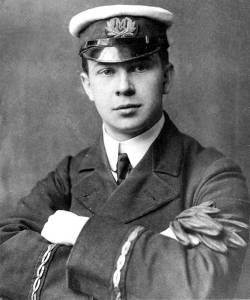
Marconi Radio Officer c1914
On 1st January, 1954 one of the most important alterations for several years came about with the introduction of P&O braid for Radio Officers. Until this date the Radio Officer in P&O ships had been almost entirely employed by the Marconi International Marine Company, and wore the standard Merchant Navy uniform, with a distinctive Marconi cap badge and braid on the cuffs. On becoming employees of the P&O, they were given shoulder straps in uniformity with the Navigating Officers, but with green as the background colour for their Department.
1955 saw another addition to the Purser's Department uniforms with the introduction of the rank of Senior Assistant Purser, identified by two stripes over white on the shoulder. This rank which was granted to Assistant Pursers of five years' seniority, brought the Purser's Department more into line with the other Departments.
In 1957 the Commander's title was changed to Captain, with uniforms remaining unchanged, until the amalgamation with the Orient Line and the introduction of Purser Cadets, with their white twist and button on a white collar patch.
From 1st January 1963, the Orient Line uniform was replaced by the P & O uniform in the combined fleets of the P&O-Orient Line.
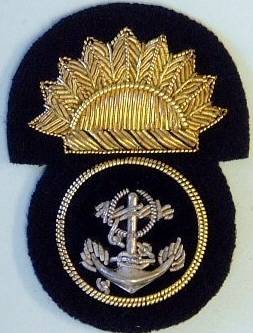
Petty Officers' uniforms saw the House Flag cap badge giving way to a replica of the badges worn by Chief Petty Officers and Petty Officers of the Royal Navy, with the single difference that the Rising Sun replaced the Crown

This is a work in progress, and photographs and further information would be much appreciated - particularly regarding female staff, catering staff, stewards, stewardesses, hostesses, etc....
Nick Messinger January 2019
E-mail: nick.messinger@gmail.com